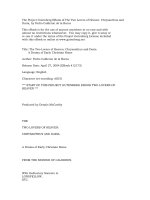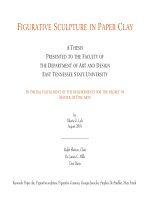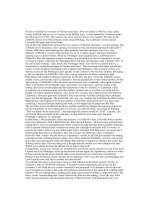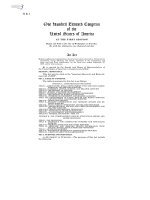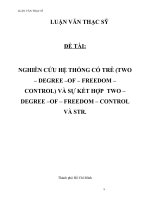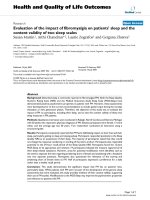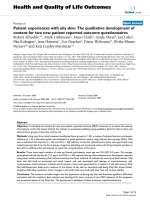- Trang chủ >>
- Khoa Học Tự Nhiên >>
- Vật lý
lecture 6 dof the two degree of freedom
Bạn đang xem bản rút gọn của tài liệu. Xem và tải ngay bản đầy đủ của tài liệu tại đây (376 KB, 14 trang )
53/58:153 Lecture 6 Fundamental of Vibration
______________________________________________________________________________
- 1 -
Lecture 6: Modal Superposition
Reading materials: Section 2.3
1. Introduction
Exact solution of the free vibration problems is
where coefficients can be determined from the initial conditions.
The method is not practical for large systems since two unknown coefficients
must be introduced for each mode shape.
Modal superposition is a powerful idea of obtaining solutions. It is applicable to
both free vibration and forced vibration problems.
The basic idea
To use free vibrations mode shapes to uncouple equations of motion.
The uncoupled equations are in terms of new variables called the modal
coordinates.
Solution for the modal coordinates can be obtained by solving each equation
independently.
A superposition of modal coordinates then gives solution of the original
equations.
Notices
It is not necessary to use all mode shapes for most practical problems.
Good approximate solutions can be obtained via superposition with only
first few mode shapes.
53/58:153 Lecture 6 Fundamental of Vibration
______________________________________________________________________________
- 2 -
2. Orthogonality of undamped free vibration mode shapes
An n degree of freedom system has n natural frequencies and n corresponding
mode shapes.
Mass orthogonality:
Proof:
Mass nomalization:
53/58:153 Lecture 6 Fundamental of Vibration
______________________________________________________________________________
- 3 -
Stiffness orthogonality:
Proof:
3. Modal superposition for undamped systems – Uncoupling of the
Equations of motion
Equations of motion of an undamped multi-degree of freedom system
The displacement vector can be written as a linear combination of the mode
shape vectors.
or in matrix form,
53/58:153 Lecture 6 Fundamental of Vibration
______________________________________________________________________________
- 4 -
Then, the equations of motion
First term becomes a modal mass matrix using mass orthogonalitys
Second term becomes a stiffness matrix using stiffness orthogonality
Here is the modal load vector
53/58:153 Lecture 6 Fundamental of Vibration
______________________________________________________________________________
- 5 -
The equations of motion are uncoupled and known as the modal equations
or
Recall natural frequencies
Then
Obviously, each modal equation represents an equivalent single degree of freedom
system.
Rewrite the initial conditions for the modal equations
53/58:153 Lecture 6 Fundamental of Vibration
______________________________________________________________________________
- 6 -
Finally, the modal equations are
4. Modal superposition for undamped systems – Solution of the modal
equations
For free vibrations, the modal equations are:
0)()(
2
=+ tztz
iii
ω
&&
For each equation, the solution is
or
53/58:153 Lecture 6 Fundamental of Vibration
______________________________________________________________________________
- 7 -
where
Then, the solution for the original equations of motion is
Indeed, the above solution is the exact solution. The approximate solution can be
obtained via using the first few mode shapes.
The above equations are general expressions for both free vibration and forced
vibration.
For forced vibration,
)(tz
i
could be obtained from the solution of one DOF
forced vibration.
5. Examples
53/58:153 Lecture 6 Fundamental of Vibration
______________________________________________________________________________
- 8 -
Eigenvalues, frequencies, and mode shapes
a. Uncoupling equations of motion
I.C.s:
Modal equations:
53/58:153 Lecture 6 Fundamental of Vibration
______________________________________________________________________________
- 9 -
b. solution
6. Rayleigh damping
The undamped free vibration mode shapes are orthogonal with respect to the
mass and stiffness matrices.
Generally, the undamped free vibration mode shapes are not orthogonal with
respect to the damping matrix.
Generally, equations of motion for damped systems cannot be uncoupled.
53/58:153 Lecture 6 Fundamental of Vibration
______________________________________________________________________________
- 10 -
However, we can choose damping matrix to be a linear combination of the
mass and stiffness matrices. Then, the mode shapes are orthogonal with respect to
the damping matrix, and the equations of motion can be uncoupled.
Damping matrix
Equations of motion
Displacement vector
where
,
Uncoupling equations of motion
where
Rewrite the equations of motion
53/58:153 Lecture 6 Fundamental of Vibration
______________________________________________________________________________
- 11 -
where
There are
So that
Free vibration solution of an undamped system
Therefore, the exact solution is
Approximate solution can be obtained via using the first few mode shapes as usual.
53/58:153 Lecture 6 Fundamental of Vibration
______________________________________________________________________________
- 12 -
Example 1:
In a four DOF system the damping in the first mode is 0.02 and in the fourth mode
is 0.01. Determine the proportional damping matrix and calculate the damping in
the second and third modes.
Damping in the first mode and fourth mode:
The coefficients in the damping matrix can be determined as
Damping in other modes:
53/58:153 Lecture 6 Fundamental of Vibration
______________________________________________________________________________
- 13 -
The damping matrix is
Example 2:
Obtain a free vibration solution for a four DOF system using only two modes.
Assume 5% damping in the first two modes.
First two modes:
Uncoupling equations of motion
53/58:153 Lecture 6 Fundamental of Vibration
______________________________________________________________________________
- 14 -
Modal equations:
Solutions:
Final solutions:
